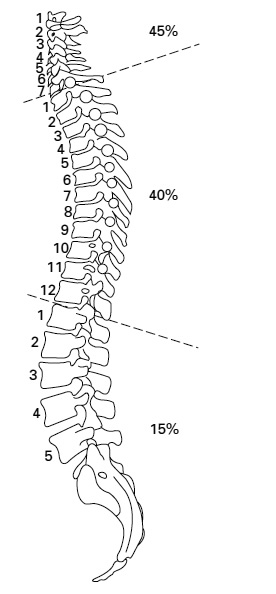History and epidemiology of spinal cord injury
History and epidemiology of spinal cord injury
Spinal cord injury is a mortal condition and has been recognised as such since antiquity. In about 2500 BC, in the Edwin Smith papyrus, an unknown Egyptian physician accurately described the clinical features of traumatic tetraplegia (quadriplegia) and revealed an awareness of the awful prognosis with the chilling advice: “an ailment not to be treated”. That view prevailed until the early years of this century. In the First World War 90% of patients who suffered a spinal cord injury died within one year of wounding and only about 1% survived more than 20 years. Fortunately, the vision of a few pioneers — Guttmann in the United Kingdom together with Munro and Bors in the United States — has greatly improved the outlook for those with spinal cord injury, although the mortality associated with tetraplegia was still 35% in the 1960s. The better understanding and management of spinal cord injury have led to a reduction in mortality and a higher incidence of incomplete spinal cord damage in those who survive. Ideal management now demands immediate evacuation from the scene of the accident to a centre where intensive care of the patient can be undertaken in liaison with a specialist in spinal cord injuries.
At present the annual incidence of spinal cord injury within the United Kingdom is about 10 to 15 per million of the population. In recent years there has been an increase in the proportion of injuries to the cervical spinal cord, and this is now the most common indication for admission to a spinal injuries unit.
Only about 5% of spinal cord injuries occur in children, mainly following road trauma or falls from a height greater than their own, but they sustain a complete cord injury more frequently than adults.
Although the effect of the initial trauma is irreversible, the spinal cord is at risk from further injury by injudicious early management. The emergency services must avoid such complications in unconscious patients by being aware of the possibility of spinal cord injury from the nature of the accident, and in conscious patients by suspecting the diagnosis from the history and basic examination. If such an injury is suspected the patient must be handled correctly from the outset.
Causes of spinal cord injury — 126 new patient admissions to Duke of Cornwall Spinal Treatment Centre (1997–99):
Accidents |
% |
| Road traffic accidents | 45 |
| Car, van, coach, lorry | 16.5 |
| Motorcycle | 20 |
| Cycle | 5.5 |
| Pedestrian | 1.5 |
| Aeroplane, helicopter | 1.5 |
| Self harm and criminal assault | 6 |
| Self harm | 5 |
| Criminal assault | 1 |
| Domestic and industrial accidents | 34 |
| Domestic — e.g. falls downstairs or from trees or ladders | 22 |
| Accidents at work — e.g. falls from scaffolding or ladders, crush injuries | 12 |
| Injuries at sport | 15 |
| Diving into shallow water | 4 |
| Rugby | 1 |
| Horse riding | 3 |
| Miscellaneous — e.g. gymnastics, motocross, skiing, etc | 7 |
See also
- At the accident:
- History and epidemiology of spinal cord injury
- Spinal injuries management at the scene of the accident
- Evacuation and initial management at hospital:
- Evacuation and transfer to hospital of patients with spinal cord injuries
- Initial management of patients with spinal cord injuries at the receiving hospital
- Neurological assessment of patients with spinal cord injuries
- Spinal shock after severe spinal cord injury
- Partial spinal cord injury syndromes
- Radiological investigations:
- Initial radiography of patients with spinal cord injuries
- Cervical injuries
- Thoracic and lumbar injuries
- Early management and complications of spinal cord injuries — I:
- Respiratory complications
- Cardiovascular complications
- Prophylaxis against thromboembolism
- Initial bladder management
- The gastrointestinal tract
- Use of steroids and antibiotics
- The skin and pressure areas
- Care of the joints and limbs
- Later analgesia
- Trauma re-evaluation
- Early management and complications of spinal cord injuries — II:
- The anatomy of spinal cord injury
- The spinal injury (cervical, thoracic and lumbar spine)
- Transfer to a spinal injuries unit
- Medical management in the spinal injuries unit:
- The cervical spine injuries
- The cervicothoracic junction injuries
- Thoracic injuries
- Thoracolumbar and lumbar injuries
- Deep vein thrombosis and pulmonary embolism
- Autonomic dysreflexia
- Biochemical disturbances
- Para-articular heterotopic ossification
- Spasticity
- Contractures
- Pressure sores
- Urological management of patients with spinal cord injury:
- Nursing for people with spinal cord lesion:
- Physiotherapy after spinal cord injury:
- Respiratory management
- Mobilisation into a wheelchair
- Rehabilitation
- Recreation
- Incomplete lesions
- Children
- Occupational therapy after spinal cord injury:
- Hand and upper limb management
- Home resettlement
- Activities of daily living
- Communication
- Mobility
- Leisure
- Work
- Social needs of patient and family:
- Transfer of care from hospital to community:
- Education of patients
- Teaching the family and community staff
- Preparation for discharge from hospital
- Easing transfer from hospital to community
- Travel and holidays
- Follow-up
- Later management and complications after spinal cord injury — I:
- Late spinal instability and spinal deformity
- Pathological fractures
- Post-traumatic syringomyelia (syrinx, cystic myelopathy)
- Pain
- Sexual function
- Later management and complications after spinal cord injury — II:
- Later respiratory management of high tetraplegia
- Psychological factors
- The hand in tetraplegia
- Functional electrical stimulation
- Ageing with spinal cord injury
- Prognosis
- Spinal cord injury in the developing world:






